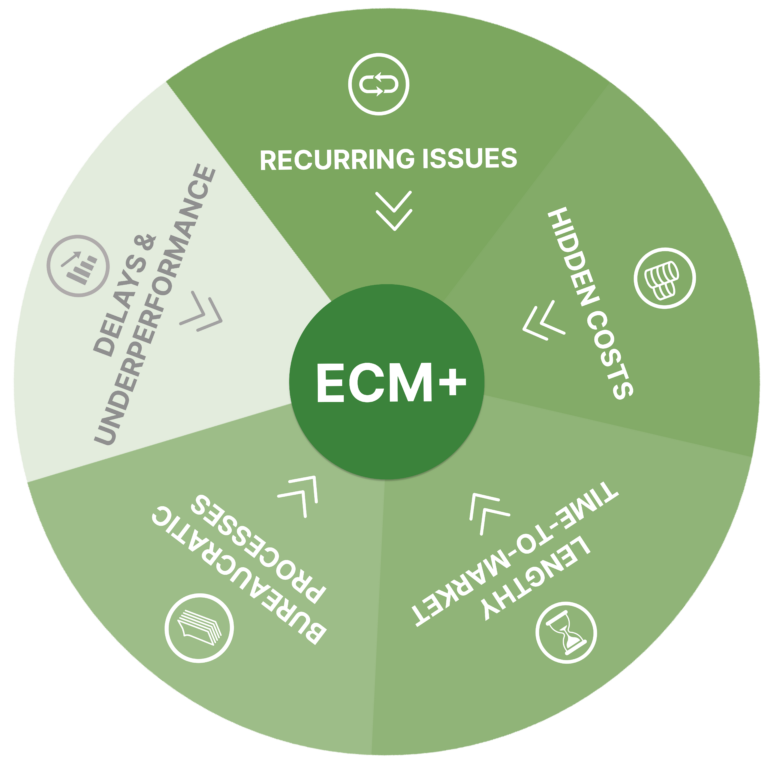Check Your Organizational Pains
Spin (click) the wheel to learn more about each individual pain below!

Experiencing any of this?
Click to learn more about our ECM+ initiative.
Spin the wheel to learn more about
each individual pain below!

Reasons for:
Delays & Underperformance
Poor Planning
Inadequate upfront planning can result in unforeseen issues that cause delays and poor results.
Resource Constraints
Limited availability of key resources (personnel, tools, materials) can hinder timely and effective implementation of changes.
Weak Monitoring and Control
Ineffective tracking of progress and lack of control mechanisms can result in projects going off track.
Reasons for:
Hidden Costs
Incomplete Impact Assessment
Without thorough risk assessment and impact analysis, potential problems and costs can be missed during the planning stage.
Underestimating Complexity
The complexity of changes is often underestimated, leading to inadequate planning and budgeting for the resultant impacts.
Lack of Comprehensive Documentation
Insufficient documentation can lead to misunderstandings about how a change will impact other parts of the system.
Poor Communication
Ineffective communication and missing common information among different teams or departments can result in overlooked implications of a change.
Reasons for:
Lengthy Time-to-Market
Lack of Support and Direction
Inadequate management involvement may increase the Time to Market due to lacking decision making at the right time and stage.
Ineffective Prioritization
A lack of alignment in prioritizing changes can result in delays, as essential changes may not be addressed in a timely manner.
Poor Project Management
Every change can be seen as a small project. Insufficient management and management tools can lead to extending the Time-to-Market.
Reasons for:
Bureaucratic Processes
Increases costs
The need for specialized staff to manage and navigate the bureaucratic processes inefficiencies can result in higher operational costs overall.
Slows down decision-making
Multiple layers of approval and complex rules can significantly delay decision-making. This slow process can hinder your ability to respond quickly to market changes or opportunities.
Lowers employee morale
It can be frustrating if one’s actions constantly are being restricted by red tape. This can lead to lower job satisfaction and potentially decreased turnover rates.
Reasons for:
Recurring Issues
Superficial Problem Solving
Addressing only the symptoms rather than the underlying causes of issues leads to recurring problems. This may be due to inadequate Root Cause Analysis and lack of prioritization of finding the actual cause.
Knowledge Silos
While a Root Cause Analysis may be part of the process of investigating the why an issue reoccurred but not have the adequate knowledge at hand or within reach due to Knowledge Silos might cause incorrect and incomplete conclusions and decisions to be made.
Lack of Thorough Investigations
Failure to conduct in-depth investigations into why issues occur may result in temporary and quick fixes that do not prevent future occurrences.
Poor Validation Processes
Inadequate validation of changes can lead to repeated issues when the same problems resurface. This may also be due to not having a thoroughly test and validation phase of changes before implementation can result in recurring issues that were not identified and addressed initially.
RECURRING ISSUES
Cause:
Lorem ipsum dolor sit amet, consectetur adipiscing elit. Ut elit tellus, luctus nec ullamcorper mattis, pulvinar dapibus leo.
Solution:
Lorem ipsum dolor sit amet, consectetur adipiscing elit. Ut elit tellus, luctus nec ullamcorper mattis, pulvinar dapibus leo.
HIDDEN COSTS
Causes:
- Incomplete Impact Assessment: Without thorough risk assessment and impact analysis, potential problems and costs can be missed during the planning stage.
- Underestimating Complexity: The complexity of changes is often underestimated, leading to inadequate planning and budgeting for the resultant impacts.
- Lack of Comprehensive Documentation: Insufficient documentation can lead to misunderstandings about how a change will impact other parts of the system.
- Poor Communication: Ineffective communication and missing common information among different teams or departments can result in overlooked implications of a change.
Solution:
Lorem ipsum dolor sit amet, consectetur adipiscing elit. Ut elit tellus, luctus nec ullamcorper mattis, pulvinar dapibus leo.
LENGTHY TIME-TO-MARKET
Causes:
- Lack of Support and Direction: When management is not actively involved, teams may lack the guidance and support needed to expedite the change process. Inadequate management involvement may also increase the Time to Market due to lacking decision making at the right time and stage.
- Poor Prioritization: Misalignment in prioritizing changes can lead to delays, as critical changes may not be addressed promptly.
- Poor Project Management: Every Change can be seen as a small project. Insufficient management and management tools can lead to extending the Time to Market.
Solution:
Lorem ipsum dolor sit amet, consectetur adipiscing elit. Ut elit tellus, luctus nec ullamcorper mattis, pulvinar dapibus leo.
BUREAUCRATIC PROCESSES
Cause:
Lorem ipsum dolor sit amet, consectetur adipiscing elit. Ut elit tellus, luctus nec ullamcorper mattis, pulvinar dapibus leo.
Solution:
Lorem ipsum dolor sit amet, consectetur adipiscing elit. Ut elit tellus, luctus nec ullamcorper mattis, pulvinar dapibus leo.
DELAYS & UNDERPERFORMANCE
Causes:
- Poor Planning: Inadequate upfront planning can result in unforeseen issues that cause delays and poor results.
- Resource Constraints: Limited availability of key resources (personnel, tools, materials) can hinder timely and effective implementation of changes.
- Weak Monitoring and Control: Ineffective tracking of progress and lack of control mechanisms can result in projects going off track.
Solution:
Lorem ipsum dolor sit amet, consectetur adipiscing elit. Ut elit tellus, luctus nec ullamcorper mattis, pulvinar dapibus leo.


